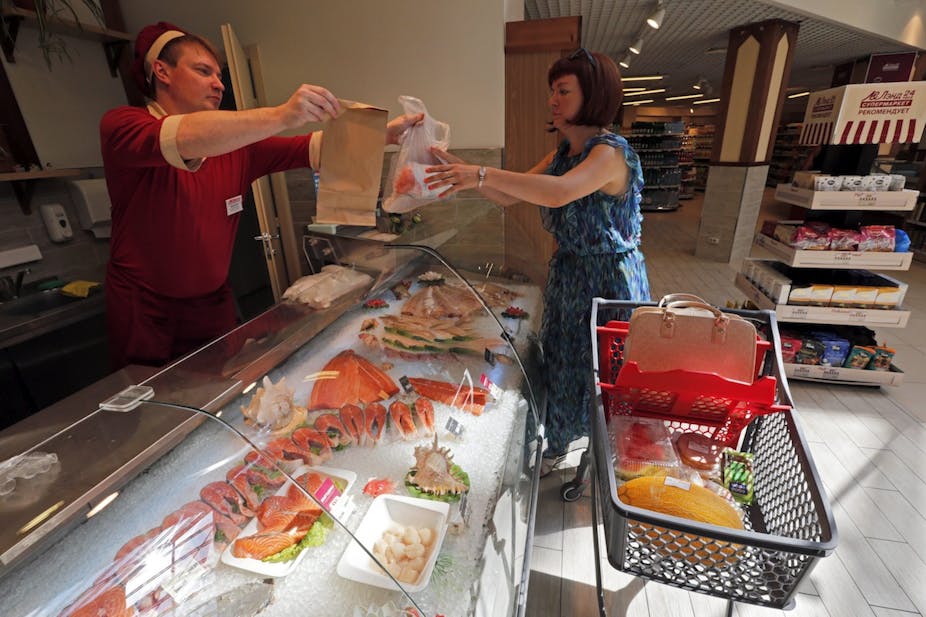When Russia announced counter-sanctions against the European Union, USA, Canada and Australia banning imports of food items from those countries, it was clear there would be imminent consequences. But just how those are playing out isn’t as some had expected.
According to President Putin’s economic adviser Sergey Glazyev, the imported component of food accounted for in Russia is 39%. This is almost twice the 20% maximum that should be allowed for food security reasons according to Glazyev himself. Meanwhile, some other sources quote a proportion of imports considerably higher than 39%.
The immediate result of restrictions on imports, if substitutes are not found, should be a considerable increase in prices. It is incorrect to suggest, like various commentators in Russia do, that price increases should only affect luxury imported foods, such as exclusive sorts of French cheese and Spanish ham. They have argued locally produced basic items, such as meat and milk, would not be affected and, therefore, ordinary people consuming ordinary food should not feel the impact.
On the contrary, shoppers facing increases in prices for imported products inevitably switch to domestically supplied alternatives. This results in the price of domestic alternatives being pushed up. Exactly this is happening. Reportedly, prices for both imported and domestically produced salmon have already gone up by 50-60%.
Meanwhile, many commentators and ordinary people in Russia think that banning imports will help local farmers and the food industry to develop domestic production and keep prices down. But to what extent is the substitution of imports with increasing local produce possible?
The loss of domestic agriculture
Over the last one hundred years agriculture in Russia has been in a state of continuous deterioration. First, the sector lost men and women in two world wars, the civil war, Stalin’s repressions and starvation caused by collectivisation of the early 1930s. Then, the most active people began leaving rural areas for better economic opportunities in industrial towns.
As a result, an increasing proportion of farmland was abandoned, and most of those who stayed on the land lost incentives to productively farm it under the inefficient collective farm system.
During the post-communist years, this legacy has not been overcome. There has been no incentive to develop domestic agriculture. Importing has been an easier and cheaper option, and money for imports has been abundantly earned through the export of mineral and fuel commodities.
It’s difficult to see how the current situation can be reversed, certainly not in the short period of time required to prevent devastating “food inflation”.
Is it possible for Russia to replace imports from the countries subjected to counter-sanctions with products from other countries? Meat can be sourced from Brazil and Argentina, but South American exporters have already increased their prices for Russia, blaming sanctions.
Replacing imported fruit and vegetables, such as Jonathan apples from Poland with local ones, does not look easy either. Russia has failed to establish a viable industry of fresh fruit and vegetables with a shelf life long enough for transporting long distances and stocking supermarkets.
Perishable produce used to be sourced for major cities from nearby orchards and vegetable gardens, better bought in farm markets than in shops. But with the expansion of major cities into surrounding farmland, land under orchards and vegetable gardens was already dramatically reduced in the last decades of the Soviet era, while the state-owned procurement system completely failed.
In the mean time, the expected has happened. Prices for food items reportedly jumped by 30-40% in August alone.
The danger of social unrest
Of course, the government realises food is a necessity and that unavoidable increases in prices for food items will see low income families that spend a greater proportion of their incomes on food hit first. Therefore, no matter what the official propaganda says, the counter-sanctions affect Russia’s vulnerable population more than “enemy” countries.
Now the Communist faction in Duma (the Russian parliament) has put forward legislation that would cap the margin on basic foods at all the stages of the supply chain - from farm gate to wholesale and retail outlets. Will this legislation be adopted by Duma? Quite possibly, because with the current stock of previously imported goods depleting, prices will be increasing further, and and with it the danger of social unrest.
Will this be only the first step towards complete retail price regulation?
Economic theory together with all the experience of Russia, other former communist countries, as well as the most recent price control “experiments” in Venezuela and Zimbabwe leave no doubt that price control leads to empty shelves in shops, and ultimately - to total economic collapse.
Meanwhile, price regulation is only a part of possible response to a looming Russian economic crisis.
Glazyev has advised his leader that Russia should enhance its self-reliance and accelerate economic growth through investments drawn on central bank reserves. But how is this possible if not through the centralised investments into the industries controlled by the government?
Ultimately, it appears the country is heading back to the USSR.

